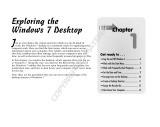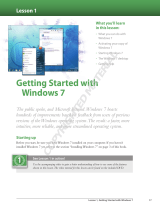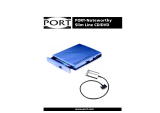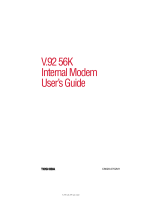Page is loading ...

2
5.375 x 8.375 ver 2.3
Model: Satellite 1110/1115
Compact Disk-ReWritable
The computer system you purchased may include a Compact Disk-
ReWritable (CD-RW), one of the most advanced storage technologies
available. As with any new technology, you must read and follow all set-up
and usage instructions in the applicable user guides and/or manuals
enclosed. If you fail to do so, this product may not function properly and
you may lose data or suffer other damage. TOSHIBA AMERICA
INFORMATION SYSTEMS (“TOSHIBA”), ITS AFFILIATES AND
SUPPLIERS DO NOT WARRANT THAT OPERATION OF THE
PRODUCT WILL BE UNINTERRUPTED OR ERROR FREE. YOU
AGREE THAT TOSHIBA, ITS AFFILIATES AND SUPPLIERS
SHALL HAVE NO RESPONSIBILITY FOR DAMAGE TO OR LOSS
OF ANY BUSINESS, PROFITS, PROGRAMS, DATA OR
REMOVABLE STORAGE MEDIA ARISING OUT OF OR
RESULTING FROM THE USE OF THE PRODUCT, EVEN IF
ADVISED OF THE POSSIBILITY THEREOF.
Protection of Stored Data
For your important data, please make periodic back-up copies of all the
data stored on the hard disk or other storage devices as a precaution against
possible failures, alteration, or loss of the data. IF YOUR DATA IS
ALTERED OR LOST DUE TO ANY TROUBLE, FAILURE OR
MALFUNCTION OF THE HARD DISK DRIVE OR OTHER
STORAGE DEVICES AND THE DATA CANNOT BE RECOVERED,
TOSHIBA SHALL NOT BE LIABLE FOR ANY DAMAGE OR LOSS
OF DATA, OR ANY OTHER DAMAGE RESULTING
THEREFROM. WHEN COPYING OR TRANSFERRING YOUR
DATA, PLEASE BE SURE TO CONFIRM WHETHER THE DATA
HAS BEEN SUCCESSFULLY COPIED OR TRANSFERRED.
TOSHIBA DISCLAIMS ANY LIABILITY FOR THE FAILURE TO
COPY OR TRANSFER THE DATA CORRECTLY.
Critical Applications
The computer you have purchased is not designed for any “critical
applications.” “Critical applications” means life support systems, medical
applications, connections to implanted medical devices, commercial
transportation, nuclear facilities or systems or any other applications where
product failure could lead to injury to persons or loss of life or catastrophic
property damage. ACCORDINGLY, TOSHIBA, ITS AFFILIATES
AND SUPPLIERS DISCLAIM ANY AND ALL LIABILITY
ARISING OUT OF THE USE OF THE COMPUTER PRODUCTS IN

3
5.375 x 8.375 ver 2.3
ANY CRITICAL APPLICATIONS. IF YOU USE THE COMPUTER
PRODUCTS IN A CRITICAL APPLICATION, YOU, AND NOT
TOSHIBA, ASSUME FULL RESPONSIBILITY FOR SUCH USE.
FCC Notice
This equipment has been tested and found to comply with the limits for a
Class B digital device, pursuant to Part 15 of the FCC rules. These limits
are designed to provide reasonable protection against harmful interference
in a residential installation.
This equipment generates, uses and can radiate radio frequency energy and,
if not installed and used in accordance with the instructions, it may cause
harmful interference to radio communications. However, there is no
guarantee that interference will not occur in a particular installation. If this
equipment does cause harmful interference to radio or television reception,
which can be determined by turning the equipment off and on, the user is
encouraged to try to correct the interference by one or more of the
following measures:
❖ Reorient or relocate the receiving antenna.
❖ Increase the separation between the equipment and receiver.
❖ Connect the equipment to an outlet on a circuit different from that to
which the receiver is connected.
❖ Consult the dealer or an experienced radio/TV technician for help.
NOTE: Only Peripherals complying with the FCC Class B limits may be attached
to this equipment. Operation with noncompliant peripherals or peripherals not
recommended by Toshiba is likely to result in interference to radio and TV
reception. Shielded cables must be used between the external devices and the
computer's or expansion unit's serial port, parallel port, monitor port, USB port,
PS/2 port
®
, i.LINK
®
port and microphone jack. Changes or modifications made
to this equipment not expressly approved by Toshiba or parties authorized by
Toshiba could void the user's authority to operate the equipment.
This device complies with Part 15 of the FCC Rules. Operation is subject to
the following two conditions:
❖ This device may not cause harmful interference.
❖ This device must accept any interference received, including
interference that may cause undesired operation.

4
5.375 x 8.375 ver 2.3
Contact:
Toshiba America Information Systems, Inc.
9740 Irvine Blvd.
Irvine, CA 92618-1697
(949) 583-3000
Industry Canada Requirement
This Class B digital apparatus complies with Canadian ICES-003.
Cet appareil numérique de la classe B est conformé à la norme NMB-003
du Canada.
FCC Requirements
The following information is pursuant to FCC CFR 47, Part 68 and refers
to internal modems.
Installation
When you are ready to install or use the modem, call your local telephone
company and give them the following information:
❖ The telephone number of the line to which you will connect the
modem.
❖ The FCC registration number of the modem.
❖ The ringer equivalence number (REN) of the modem, which is 0.6B.
The modem connects to the telephone line by means of a standard jack
called the USOC RJ11C.
Type of Service
Your modem is designed to be used on standard-device telephone lines.
Connection to telephone company-provided coin service (central office
implemented systems) is prohibited. Connection to party lines service is
subject to State tariffs. If you have any questions about your telephone line,
such as how many pieces of equipment you can connect to it, the telephone
company will provide this information upon request.
Telephone Company Procedures
The goal of the telephone company is to provide you with the best service it
can. In order to do this, it may occasionally be necessary for them to make
changes in their equipment, operations or procedures. If these changes
might affect your service or the operation of your equipment, the telephone

5
5.375 x 8.375 ver 2.3
company will give you notice, in writing, to allow you to make any changes
necessary to maintain uninterrupted service.
If Problems Arise
If any of your telephone equipment is not operating properly, you should
immediately remove it from your telephone line, as it may cause harm to
the telephone network. If the telephone company notes a problem, they
may temporarily discontinue service. When practical, they will notify you
in advance of this disconnection. If advance notice is not feasible, you will
be notified as soon as possible. When you are notified, you will be given
the opportunity to correct the problem and informed of your right to file a
complaint with the FCC. In the event repairs are ever needed on your
modem, they should be performed by Toshiba Corporation, Toshiba
America Information Systems, Inc. or an authorized representative of
Toshiba.
Disconnection
If you should ever decide to permanently disconnect your modem from its
present line, please call the telephone company and let them know of this
change.
Fax Branding
The Telephone Consumer Protection Act of 1991 makes it unlawful to use
a computer or other electronic device to send any message via a telephone
fax machine unless such message clearly contains in a margin at the top or
bottom of each transmitted page or on the first page of the transmission, the
date and time it is sent and an identification of the business, other entity or
individual sending the message and the telephone number of the sending
machine or such business, other entity or individual.
In order to program this information into your fax modem, you should
complete the setup for your fax software before sending a message.
Instructions for IC CS-03 certified equipment
1 NOTICE: The Industry Canada label identifies certified equipment.
This certification means that the equipment meets certain
telecommunications network protective, operational and safety
requirements as prescribed in the appropriate Terminal Equipment
Technical Requirements document(s). The Department does not
guarantee the equipment will operate to the user’s satisfaction.
Before installing this equipment, users should ensure that it is
permissible to be connected to the facilities of the local
telecommunications company. The equipment must also be installed
using an acceptable method of connection. The customer should be

6
5.375 x 8.375 ver 2.3
aware that compliance with the above conditions may not prevent
degradation of service in some situations.
Repairs to certified equipment should be coordinated by a
representative designated by the supplier. Any repairs or alterations
made by the user to this equipment, or equipment malfunctions, may
give the telecommunications company cause to request the user to
disconnect the equipment.
Users should ensure for their own protection that the electrical ground
connections of the power utility, telephone lines and internal metallic
water pipe system, if present, are connected together. This precaution
may be particularly important in rural areas.
Caution: Users should not attempt to make such connections
themselves, but should contact the appropriate electric inspection
authority, or electrician, as appropriate.
2 The user manual of analog equipment must contain the equipment’s
Ringer Equivalence Number (REN) and an explanation notice similar
to the following:
The Ringer Equivalence Number (REN) of this device can be found
on the label affixed to your computer.
NOTICE: The Ringer Equivalence Number (REN) assigned to each
terminal device provides an indication of the maximum number of
terminals allowed to be connected to a telephone interface. The
termination on an interface may consist of any combination of devices
subject only to the requirement that the sum of the Ringer Equivalence
Numbers of all the devices does not exceed 5.
3 The standard connecting arrangement (telephone jack type) for this
equipment is jack type(s): USOC RJ11C.
DVD-ROM Safety Instructions
The DVD-ROM drive employs a laser system. To ensure proper use of this
product, please read this instruction manual carefully and retain for future
reference. Should the unit ever require maintenance, contact an authorized
service location.
Use of controls, adjustments or the performance of procedures other than
those specified may result in hazardous radiation exposure.
To prevent direct exposure to the laser beam, do not try to open the
enclosure.
Location of the required label
(Sample shown below. Location of the label and manufacturing
information may vary.)

7
5.375 x 8.375 ver 2.3
CAUTION: This appliance contains a laser system and is classified as a “CLASS 1
LASER PRODUCT.” To use this model properly, read the instruction manual
carefully and keep it for your future reference. In case of any trouble with this
model, please contact your nearest “AUTHORIZED service station.” To prevent
direct exposure to the laser beam, do not try to open the enclosure.
Use of controls or adjustments or performance of procedures other than those
specified in the owner’s manual may result in hazardous radiation exposure.
Copyright
This guide is copyrighted by Toshiba America Information Systems, Inc.
with all rights reserved. Under the copyright laws, this guide cannot be
reproduced in any form without the prior written permission of Toshiba. No
patent liability is assumed, however, with respect to the use of the
information contained herein.
©2002 by Toshiba America Information Systems, Inc. All rights reserved.
Export Administration Regulation
This document contains technical data that may be controlled under the
U.S. Export Administration Regulations, and may be subject to the
approval of the U.S. Department of Commerce prior to export. Any export,
directly or indirectly, in contravention of the U.S. Export Administration
Regulations is prohibited.
Notice
The information contained in this manual, including but not limited to any
product specifications, is subject to change without notice.

8
5.375 x 8.375 ver 2.3
TOSHIBA CORPORATION AND TOSHIBA AMERICA
INFORMATION SYSTEMS, INC. (TOSHIBA) PROVIDES NO
WARRANTY WITH REGARD TO THIS MANUAL OR ANY OTHER
INFORMATION CONTAINED HEREIN AND HEREBY EXPRESSLY
DISCLAIMS ANY IMPLIED WARRANTIES OF MERCHANTABILITY
OR FITNESS FOR ANY PARTICULAR PURPOSE WITH REGARD TO
ANY OF THE FOREGOING. TOSHIBA ASSUMES NO LIABILITY
FOR ANY DAMAGES INCURRED DIRECTLY OR INDIRECTLY
FROM ANY TECHNICAL OR TYPOGRAPHICAL ERRORS OR
OMISSIONS CONTAINED HEREIN OR FOR DISCREPANCIES
BETWEEN THE PRODUCT AND THE MANUAL. IN NO EVENT
SHALL TOSHIBA BE LIABLE FOR ANY INCIDENTAL,
CONSEQUENTIAL, SPECIAL, OR EXEMPLARY DAMAGES,
WHETHER BASED ON TORT, CONTRACT OR OTHERWISE,
ARISING OUT OF OR IN CONNECTION WITH THIS MANUAL OR
ANY OTHER INFORMATION CONTAINED HEREIN OR THE USE
THEREOF.
Trademarks
Satellite, InTouch, and Noteworthy are registered trademarks, SelectServ,
FreedomWare, and SmartMedia are trademarks, of Toshiba America
Information Systems, Inc. and/or Toshiba Corporation.
Microsoft, Windows, DirectX, Active Desktop, and DirectShow are
registered trademarks, and Windows Media is a trademark of Microsoft
Corporation.
LapLink is a registered trademark of Traveling Software, Inc.
WinDVD is a trademark of InterVideo, Inc.
CompuServe is a registered trademark of America Online, Inc.
Dolby - Manufactured by Toshiba under license from Dolby Laboratories/
Dolby and the double-D symbol are trademarks of Dolby Laboratories.
TouchPad is a trademark of Synaptics, Inc.
All other brand and product names are trademarks or registered trademarks
of their respective companies.
Computer Disposal Information
This product contains mercury. Disposal of this material may be regulated
due to environmental considerations. For disposal, reuse or recycling
information, please contact your local government or the Electronic
Industries Alliance at www.eiae.org.

9
5.375 x 8.375 ver 2.3
Contents
Introduction ..............................................................17
This guide .............................................................. 17
Safety icons ........................................................... 18
Other icons used.............................................. 19
Other documentation ............................................. 19
Service options ...................................................... 20
Chapter 1: Finding Your Way Around ........................ 21
Making sure you have everything .......................... 21
Front with the display closed ................................. 22
Back....................................................................... 23
Right side............................................................... 24
Left side ................................................................. 25
Front with the display open.................................... 26
Indicator lights................................................. 27
System indicator panel .................................... 28
Underside .............................................................. 29

10
Contents
5.375 x 8.375 ver 2.3
Chapter 2: Getting Started ........................................ 31
Selecting a place to work ....................................... 31
Creating a computer-friendly environment....... 31
Keeping yourself comfortable .......................... 32
Precautions...................................................... 35
Setting up your computer ...................................... 37
Setting up your software.................................. 37
Registering your computer with Toshiba ......... 39
Adding external devices ................................... 39
Connecting the AC adapter..................................... 40
Charging the main battery...................................... 41
Using the computer for the first time..................... 42
Opening the display panel................................ 42
Turning on the power....................................... 42
Using the TouchPad™ ...................................... 43
Control buttons................................................ 44
Disabling or enabling the TouchPad................. 44
Installing additional memory (optional) ................. 45
Removing a memory module........................... 49
Connecting a mouse ........................................ 49
Connecting a printer ........................................ 50
Setting up a printer .......................................... 52
Turning off the computer ....................................... 55
Caring for your computer....................................... 56
Cleaning the computer..................................... 56
Moving the computer....................................... 56
Using a computer lock ..................................... 57
Chapter 3: Learning the Basics ................................. 59
Computing tips ...................................................... 59
Using the keyboard ................................................ 60
Character keys ................................................. 61
Ctrl, Fn, and Alt keys ........................................ 61
Function keys................................................... 61

11
Contents
5.375 x 8.375 ver 2.3
Windows
®
special keys.................................... 62
Overlay keys..................................................... 62
Starting a program................................................. 64
Saving your work................................................... 64
Printing your work ................................................. 65
Using diskettes ...................................................... 66
Inserting and removing diskettes..................... 66
Caring for diskettes.......................................... 66
Backing up your files ............................................. 67
Using your DVD drive ............................................ 68
DVD-ROM drive components........................... 69
Inserting a disc ................................................ 70
Playing an audio CD......................................... 72
Playing a DVD .................................................. 74
Viewing the contents of a CD or DVD............... 74
Removing a disc with the computer on............ 74
Removing a disc with the computer off ........... 75
Caring for CDs and DVDs................................. 75
Setting up for communications.............................. 76
Connecting the modem to a phone line............ 76
Connecting your computer to a network.......... 76
Powering down the computer................................ 77
Using Turn Off or Shut down ................................. 78
Hibernation command ..................................... 79
Standby command........................................... 80
Turning off more quickly .................................. 81
Starting again after Turn Off............................. 82
Using Hibernation .................................................. 82
Starting again from Hibernation mode............. 83
Using Standby ....................................................... 84
Going into Standby mode more quickly ........... 85
Starting again from Standby ............................ 86
Toshiba’s online resources..................................... 86

12
Contents
5.375 x 8.375 ver 2.3
Chapter 4: Mobile Computing ................................... 87
Toshiba’s energy-saver design ............................... 87
Running the computer on battery power ............... 88
Power management ......................................... 89
Charging the battery .............................................. 89
Charging the RTC battery................................. 90
Monitoring battery power ...................................... 91
Determining remaining battery power.............. 91
Conserving battery power................................ 92
What to do when the battery runs low ............. 93
Setting battery alarms...................................... 93
Changing the main battery ..................................... 94
Removing the battery from the computer ........ 95
Taking care of your battery..................................... 95
Maximizing battery life..................................... 96
Disposing of used batteries safely ......................... 97
Traveling tips.......................................................... 98
Chapter 5: Getting to Know the Windows
®
XP
Operating System................................. 99
Lesson 1: Exploring the desktop.......................... 100
Finding your way around the desktop ............ 100
Windows
®
XP file system .............................. 102
Lesson 2: Using the TouchPad and control
buttons together ........................................... 103
Lesson 3: Learning about the Internet ................. 106
Lesson 4: Creating a new document .................... 107
Lesson 5: Creating a new folder........................... 108
Lesson 6: Starting programs ............................... 109
Lesson 7: Resizing, repositioning, and hiding
windows ........................................................ 111
Using the taskbar........................................... 112
Minimizing and maximizing windows ............ 112
Resizing and moving windows....................... 113

13
Contents
5.375 x 8.375 ver 2.3
Lesson 8: Closing programs ............................... 115
Lesson 9: Creating shortcuts ............................... 116
Creating a shortcut to the Calculator.............. 116
Creating a shortcut to the Character Map ...... 117
Lesson 10: Changing the screen saver................. 119
Lesson 11: Setting the date and time................... 121
Lesson 12: Removing objects from the desktop.. 122
Lesson 13: Using System Restore ....................... 124
Lesson 14: If I am lost, what do I do? ................. 125
Windows
®
XP Help and Support Center ........ 125
Using the online tours and tutorials ............... 127
Lesson 15: Turning off your computer................. 128
Chapter 6: Exploring Your Options .......................... 129
Windows
®
XP special features............................. 129
Personalizing your desktop.................................. 130
Customizing the taskbar ................................ 130
Bringing the world to your desktop................ 131
Changing desktop and browsing style ........... 132
Personalizing individual windows .................. 133
Customizing window toolbars........................ 134
Displaying information about each folder ...... 135
Using your computer at the office........................ 136
Setting up for communications...................... 137
Connecting the modem to a telephone line .... 138
Setting up a dial-up connection ..................... 138
Exchanging data with another computer.............. 139
Transferring files using a parallel
port connection........................................ 139
Getting help transferring files......................... 140
Connecting to the Internet ................................... 140
An overview of using the Internet ........................ 141
The Internet ................................................... 141
The World Wide Web ..................................... 142

14
Contents
5.375 x 8.375 ver 2.3
Internet Service Providers.............................. 142
Signing up with an Internet Service Provider 142
Surfing the Internet........................................ 143
Internet features............................................. 143
Uploading and downloading files on
the Internet .............................................. 144
Exploring video features ...................................... 144
Display settings hot key ................................ 145
Exploring audio features ...................................... 146
Recording sounds.......................................... 146
Using a microphone....................................... 146
Adjusting recording settings .......................... 147
Using external speakers or headphones......... 148
Connecting a monitor, keyboard and mouse........ 148
Changing the display properties setting............... 149
Using PC Cards.................................................... 150
PC Card supporting software ......................... 150
Inserting PC Cards......................................... 150
Removing PC Cards....................................... 151
Hot swapping................................................. 152
Chapter 7: WinDVD™.............................................. 153
Playing DVDs ....................................................... 153
Using the WinDVD slider bar (location) ......... 155
Using the WinDVD control panel.......................... 156
Using the control panel playback buttons ...... 157
Maximizing the video window........................ 160
Using WinDVD Advanced Features ...................... 160
Using playlists ..................................................... 161
Creating a Playlist .......................................... 162
Playing a Playlist............................................ 163
Getting Help ......................................................... 164
Exiting WinDVD ................................................... 164

15
Contents
5.375 x 8.375 ver 2.3
Chapter 8: If Something Goes Wrong ..................... 165
Problems when you turn on the computer........... 168
The Windows
®
operating system is not working . 169
Using Startup options to fix problems ........... 169
Internet problems .......................................... 170
The Windows
®
XP operating system
can help you ............................................ 171
Resolving a hardware conflict.............................. 171
A plan of action.............................................. 172
Resolving hardware conflicts on your own .... 172
Fixing a problem with Device Manager .......... 174
Memory card problems.................................. 176
Power and the batteries ................................. 176
Keyboard problems........................................ 178
Display problems ........................................... 178
Disk drive problems....................................... 180
DVD-ROM drive problems ............................. 182
Sound system problems ................................ 191
PC Card problems.......................................... 191
Printer problems............................................ 194
Modem problems........................................... 195
Develop good computing habits .......................... 196
If you need further assistance.............................. 197
Before you call ............................................... 197
Contacting Toshiba ........................................ 198
Other Toshiba Internet Web sites ........................ 199
Toshiba’s worldwide offices ................................. 200

16
Contents
5.375 x 8.375 ver 2.3
Appendix A: Hot Keys ............................................. 203
Instant password security.................................... 203
Without a password....................................... 203
With a password ............................................ 203
Maintaining security when the battery
isn’t fully charged .................................... 204
Sound .................................................................. 205
Display modes ..................................................... 205
Disabling or enabling the TouchPad..................... 206
Keyboard hot keys ............................................... 206
Appendix B: Power Cable Connectors..................... 207
Glossary ................................................................. 209
Index ....................................................................... 225

17
5.375 x 8.375 ver 2.3
Introduction
Welcome to the world of powerful and portable multimedia
computers! With your new Toshiba notebook computer, your
access to information can accompany you wherever you go.
You will find your operating system, Microsoft
®
Windows
®
XP
already installed on your computer. Your operating system offers
exciting features and easy Internet access.
This guide contains information about your operating system and
how it functions with your Toshiba computer. For specific
information on the software, see the Microsoft booklet that
shipped with your computer.
This guide
This guide introduces the computer’s features. You can:
❖ Read the entire guide from beginning to end.
❖ Skim through and stop when a topic interests you.
❖ Use the table of contents and the index to find specific
information.

18
Introduction
Safety icons
5.375 x 8.375 ver 2.3
If you are new to computers, or have not used a notebook
computer before, read through the first couple of chapters to
familiarize yourself with the components of the computer and how
to turn it on. After that, seek out whatever interests you most.
Safety icons
This manual contains safety instructions that must be observed in
order to avoid potential hazards that could result in personal
injuries, damage to your equipment, or loss of data. These safety
cautions have been classified according to the seriousness of the
risk, and the icons highlight these instructions as follows:
DANGER: This icon indicates the existence of a hazard that could
result in death or serious bodily injury if the safety instruction is
not observed.
WARNING: This icon indicates the existence of a hazard that could
result in bodily injury if the safety instruction is not observed.
CAUTION: This icon indicates the existence of a hazard that could
result in damage to equipment or property if the safety instruction
is not observed.
NOTE: This icon indicates information that relates to the safe
operation of the equipment or related items.

19
Introduction
Other documentation
5.375 x 8.375 ver 2.3
Other icons used
Additional icons highlight other helpful or educational
information:
TECHNICAL NOTE: This icon highlights technical information
about the computer.
HINT: This icon denotes helpful hints and tips.
DEFINITION: This icon indicates the definition of a term used in
the text.
Other documentation
Your computer comes with the following documentation:
❖ This electronic user’s guide. Look for the user’s guide icon on
your desktop or in the DOCS folder on the C: drive.
❖ Guides for other programs that may come preinstalled on
your computer or that are available for installation on your
Recovery CDs.
❖ Toshiba accessories information, which lists accessories
available from Toshiba and explains how to order them.
❖ The Microsoft
®
Windows
®
operating system documentation
which explains the features of the operating system.

20
Introduction
Service options
5.375 x 8.375 ver 2.3
Service options
Toshiba offers a full line of service options built around its
SelectServ
TM
warranty programs. For more information, visit
Toshiba’s Web site at
toshiba.com.
If you have a problem or need to contact Toshiba, see “If
Something Goes Wrong” on page 165.
/




